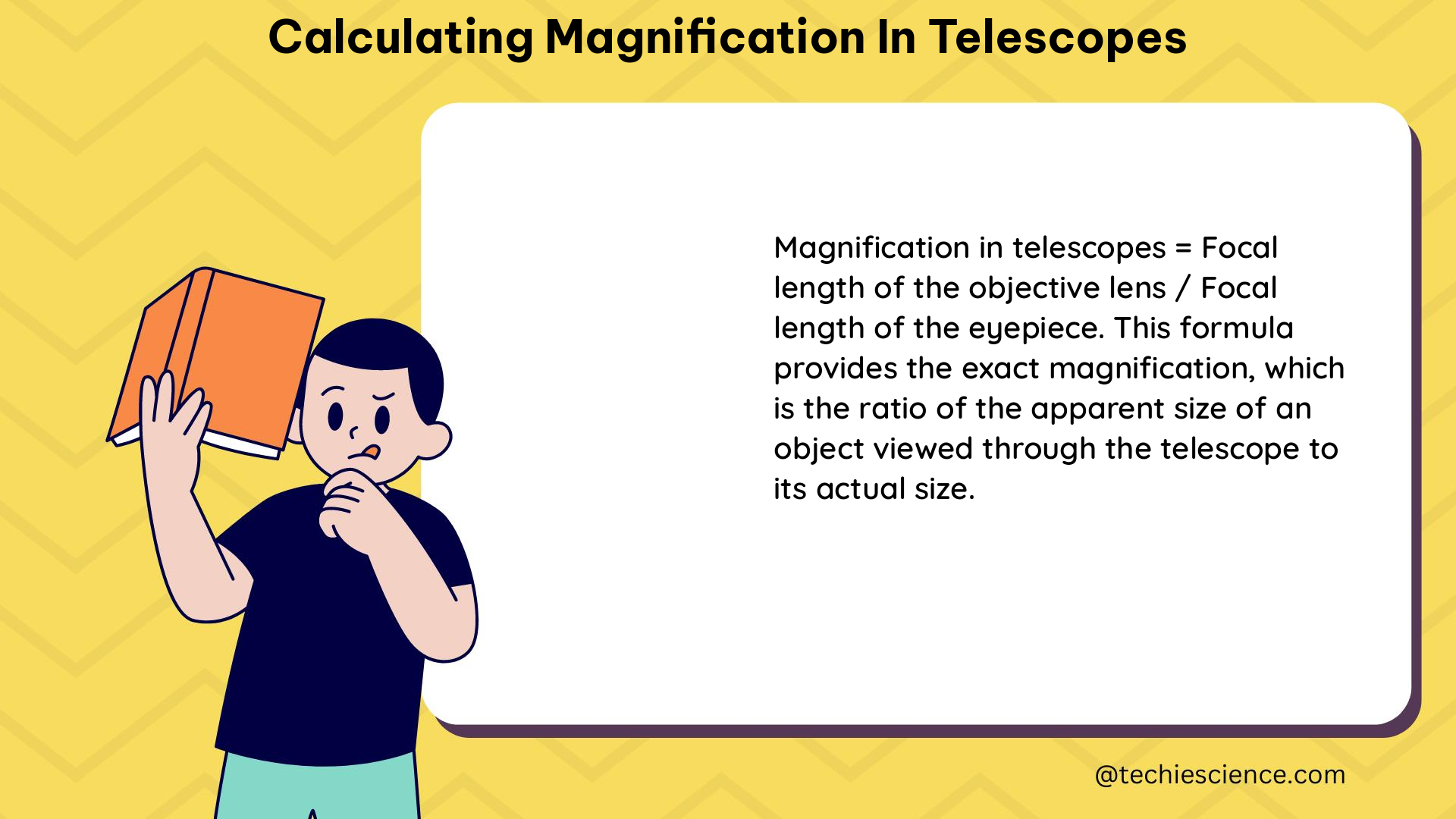Telescopes are essential tools for astronomers and stargazers, allowing them to observe distant celestial objects with unprecedented clarity and detail. One of the most crucial aspects of using a telescope is understanding how to calculate its magnification, which determines the size and scale of the objects you observe. In this comprehensive guide, we will delve into the intricacies of calculating magnification in telescopes, providing you with the knowledge and tools to get the most out of your astronomical observations.
Understanding Telescope Magnification
The magnification of a telescope is the ratio of the focal length of the objective lens or mirror to the focal length of the eyepiece. This relationship is expressed by the formula:
Magnification = Focal length of the objective / Focal length of the eyepiece
For example, if the focal length of the objective is 1000 mm and the focal length of the eyepiece is 20 mm, the magnification would be:
Magnification = 1000 mm / 20 mm = 50x
This means that the image you see through the telescope is 50 times larger than the image you would see with the naked eye.
Importance of Focal Length

The focal length of a lens or mirror is the distance between the center of the lens or mirror and the point where the light rays converge or diverge. This distance is a crucial factor in determining the magnification of a telescope.
To calculate the focal length of a lens or mirror, you can use the formula:
1/f = 1/u + 1/v
Where:
– f is the focal length
– u is the object distance
– v is the image distance
For example, if the object distance is 100 mm and the image distance is 200 mm, the focal length would be:
1/f = 1/100 mm + 1/200 mm
f = 66.67 mm
Factors Affecting Magnification
In addition to the focal length of the objective and eyepiece, there are several other factors that can affect the magnification of a telescope:
-
Aperture: The diameter of the objective lens or mirror, which determines the amount of light the telescope can collect. A larger aperture will result in a brighter and more detailed image.
-
Exit Pupil: The diameter of the beam of light leaving the eyepiece, which determines how much of the light collected by the telescope enters your eye. A larger exit pupil will result in a brighter image.
-
Field of View: The width of the area you can see through the telescope, which affects the size and scale of the objects you observe. A wider field of view will allow you to see more of the sky at once.
-
Atmospheric Conditions: The stability and transparency of the atmosphere, which can affect the sharpness and clarity of the image. Factors like seeing and transparency can impact the magnification and overall quality of the observation.
Choosing the Right Eyepiece
To get the most out of your telescope, it’s important to choose the right eyepiece for the object you’re observing. Generally, a longer focal length eyepiece will provide a lower magnification, which is useful for observing large objects like galaxies and nebulae. A shorter focal length eyepiece will provide a higher magnification, which is useful for observing smaller objects like planets and the moon.
As a rule of thumb, it’s recommended to use a magnification that is approximately 50 times the aperture of the telescope in millimeters. For example, a 4-inch (100 mm) telescope should be used with a magnification of around 50x, while a 10-inch (250 mm) telescope should be used with a magnification of around 125x.
Calculating Magnification: Examples and Numerical Problems
Let’s explore some examples and numerical problems to better understand the calculation of magnification in telescopes.
Example 1:
Objective focal length: 1000 mm
Eyepiece focal length: 20 mm
Magnification = 1000 mm / 20 mm = 50x
Example 2:
Objective focal length: 2000 mm
Eyepiece focal length: 10 mm
Magnification = 2000 mm / 10 mm = 200x
Numerical Problem 1:
A telescope has an objective focal length of 1500 mm and an eyepiece focal length of 25 mm. Calculate the magnification of the telescope.
Solution:
Magnification = Objective focal length / Eyepiece focal length
Magnification = 1500 mm / 25 mm = 60x
Numerical Problem 2:
A telescope has an objective diameter of 150 mm and an eyepiece focal length of 15 mm. Calculate the magnification of the telescope.
Solution:
Magnification = Objective focal length / Eyepiece focal length
Objective focal length = Aperture / (Focal ratio)
Focal ratio = 10 (typical for a reflector telescope)
Objective focal length = 150 mm / 10 = 1500 mm
Magnification = 1500 mm / 15 mm = 100x
Conclusion
Calculating the magnification of a telescope is a crucial skill for any astronomer or stargazer. By understanding the relationship between the focal lengths of the objective and eyepiece, as well as the other factors that affect magnification, you can optimize your telescope setup and get the most out of your astronomical observations. Remember to always consider the atmospheric conditions and choose the right eyepiece for the object you’re observing to ensure the best possible viewing experience.
Reference:
- Calculation of magnification in low vision | PPT – SlideShare
- Calculating the Magnification of a Telescope – Space Math @ NASA
- How to Measure the Apparent Magnification of a Scope – Precision Rifle Blog

The lambdageeks.com Core SME Team is a group of experienced subject matter experts from diverse scientific and technical fields including Physics, Chemistry, Technology,Electronics & Electrical Engineering, Automotive, Mechanical Engineering. Our team collaborates to create high-quality, well-researched articles on a wide range of science and technology topics for the lambdageeks.com website.
All Our Senior SME are having more than 7 Years of experience in the respective fields . They are either Working Industry Professionals or assocaited With different Universities. Refer Our Authors Page to get to know About our Core SMEs.